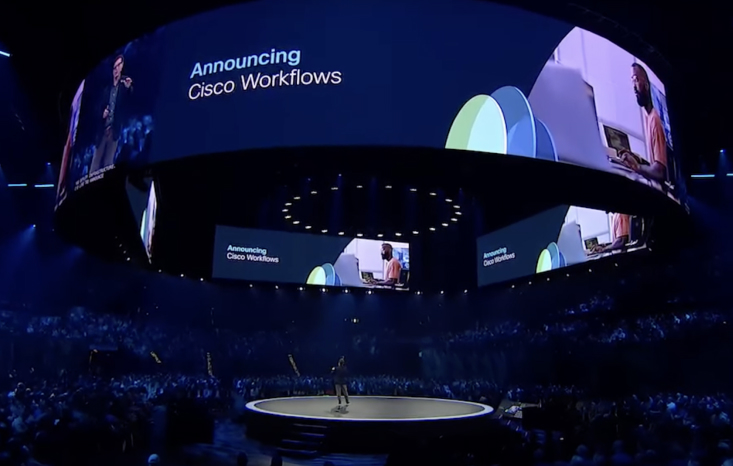Cisco Unveils Workflows in Cisco Networking Cloud for Secure Network Automation

Gartner’s Market Guide for Network Automation Platforms highlights that more than 65% of enterprise networking activities are performed manually, and only a small but growing percentage of large enterprises automate more than half of their network activities. Delivering superior digital experiences for an enterprise involves powering multiple, disparate networking domains and/or deploying multiple solutions within a single domain. This results in multiple challenges for network operators, including:
- Cross-domain and cross-product integration result in “swivel chair” effect—context-switching between multiple management consoles and dashboards—and require expertise of individual products and services to drive the required configuration.
- Existing community automation tools require scripting skills, as well as additional investment, to enable collaboration and governance, and support production-grade automation against different products and services in an enterprise setting.
As a result, users experience steep learning curves, lengthy implementation times, and ultimately suboptimal and under-maintained automation adoption across their global infrastructure.
To address this complexity, we announced Cisco Workflows, a new set of capabilities at the heart of Cisco Networking Cloud, earlier this month in June at Cisco Live US 2024. Delivered as a cloud-hosted service, organizations can use Workflows to define, automate, and orchestrate configuration tasks within and across their domains—branches and sites, campuses, data centers, clouds—with just a few clicks using a low- to no-code environment. Cisco Workflows helps users focus on accelerating business value, increase infrastructure usage and efficiencies, and reduce costs and time lost to manual errors.

Workflows offers out-of-the-box automation across multiple products and domains, following design guidelines and best practices recommended in Cisco Validated Designs (CVDs). A powerful set of low- to no-code customization options (e.g., drag-and-drop API tasks, data transformation) enable users to easily modify and extend the automations for their specific use case. Workflows automates both cloud-hosted service APIs and on-premises network controller API endpoints. A secure cloud connectivity service hosted on-premises enables the connectivity from Workflows to the on-premises endpoints. Users get real-time updates to track workflows execution progress, pause execution to accept inputs from other users within the organization, and review audit logs of previous automation runs. Workflows will be accessible from within Cisco Networking Cloud’s Cross Platform Navigator, via single sign-on (SSO), and through embedded links in various Cisco controllers.
Today, Cisco Workflows includes the following Cisco controller adapters to run automation—Application Centric Infrastructure (ACI), Catalyst Center, Identity Services Engine (ISE), Catalyst SD-WAN, Meraki, and many more. The automation hub provides two ready-to-go sample validated automations using these adapters:
- Campus to data center establishes a networking fabric, with macro- and microsegmentation, securely connecting users in campus (Catalyst Center and Identity Service Engine) to workloads and applications running in a data center (Application Centric Infrastructure).
- Automated hybrid branch site deployment for branches that include a mix of Meraki (Wi-Fi and LAN) and Catalyst infrastructure (SD-WAN for routing). The automation performs inventory pre-checks, onboards devices within the Meraki and Catalyst SD-WAN, and establishes connectivity between them.

Workflows, as a low-code procedural automation capability, provides the fine-grained control and insights into execution flow required for the flexible implementation, debugging, and troubleshooting of cross-domain automation. Workflows resides on a platform that holds multiple certifications including ISO 27001, ISO 27017, SOC 2 Type 2, SOC 3, CSA, and STAR 1, underscoring our unwavering commitment to data security and compliance. The service is designed to effortlessly scale automation across millions of endpoints worldwide while ensuring unmatched security and seamless integration with hybrid cloud environments.
With this advancement, we continue to simplify the experience for our customers, empowering organizations to thrive in today’s dynamic digital landscape with confidence and ease. Customers and partners are already going through beta trials with Cisco Workflows.
“As beta testers, we are beginning to explore the new cross-domain automation functionality within Cisco Workflows. We are starting to migrate some of our existing automation scripts to the Workflows system and are excited to see how these capabilities will be able to simplify tasks for our customers in the future.” —Stefan Ronge, NTS (a managed service provider in Europe).
“We have been exploring the beta capabilities provided within Cisco Workflows and see a real potential to help automate key parts of the networking infrastructure. Our evaluation has been running on complex multi-domain infrastructures including Catalyst Center SDA and ACI.” —Ingmar Schön, EnvOcean Network Systems (a network consulting firm in Europe).
Share:

